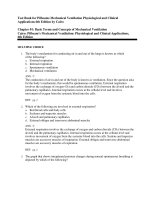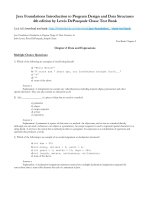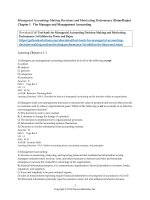Test bank for introduction to radiologic sciences and patient care 4th edition by adler
Bạn đang xem bản rút gọn của tài liệu. Xem và tải ngay bản đầy đủ của tài liệu tại đây (39.45 KB, 4 trang )
buy this full document at
Adler: Introduction to Radiologic Sciences and Patient Care, 4th Edition
Test Bank
Chapter 01: Introduction to Radiologic Technology
MULTIPLE CHOICE
1. The film record produced to visualize the internal structures of the body is called:
a. x-rays
b. roentgen
c. radiography
d. radiograph
ANS: D
2. A discipline that involves visualizing a patient’s organs by the introduction of a
radiopharmaceutical is called:
a. computed tomography
b. cardiovascular interventional technology
c. nuclear medicine technology
d. radiation therapy
ANS: C
3. Which of the following are forms of energy?
a. mechanical
b. nuclear
c. electromagnetic
d. heat
e. all of the above
ANS: E
4. Any process by which a neutral atom gains or loses an electron is called:
a. ionization
b. polarization
c. electrolysis
d. neutralization
ANS: A
buy this full document at
Full file at />5. Which discipline uses high-energy ionizing radiation to treat malignant diseases?
a. nuclear medicine
b. computed tomography
c. cardiovascular interventional technology
d. radiation therapy
e. medical sonography
ANS: D
6. An example of a use of electrical energy is:
a. EEG
b. sonography
c. thermograms
d. x-rays
ANS: A
7. Radiography images what part of the body?
a. chest
b. abdomen
c. skeletal structure
d. gastrointestinal tract
e. all of the above
ANS: E
8. To image the blood vessels in the body, the physician must:
a. order a nuclear medicine scan
b. inject a contrast medium
c. use special film/screen combinations
d. none of the above
ANS: B
9. The branch of medicine that studies diseases of internal organs of the chest and abdomen is
called:
a. family practice
b. internal medicine
c. orthopedics
d. gynecology
e. oncology
ANS: B
Copyright © 2007, 2003, 1999, 1994 by Saunders, an imprint of Elsevier Inc.
Full file at />10. Which of these radiography departments uses ionizing radiation?
a. magnetic resonance imaging
b. diagnostic medical sonography
c. radiation therapy
d. all of the above
e. none of the above
ANS: C
11. Mammography was established:
a. to detect breast cancer early
b. to visualize the blood vessels
c. to view patient anatomy from sectional planes
d. to treat early breast cancers
ANS: A
12. What is the relationship between MRI and CT?
a. Both use ionizing radiation.
b. Radiographers in these areas have advanced educational degrees.
c. Cardiologists perform the exams in MRI.
d. Both visualize anatomy in sectional planes.
ANS: D
13. What is the difference between a technician and a technologist?
a. A technician has a higher educational level.
b. A technologist applies knowledge to problems encountered on the job.
c. Technicians learn their skills on the job.
d. Both work under the direction of a nurse.
ANS: B
14. Which of the following is an example of a person who provides direct patient care under the
supervision of a physician?
a. registered nurse
b. surgeon
c. health information technologist
d. medical technologist
ANS: A
15. Who was responsible for the discovery of x-rays?
a. Anna Bertha Ludwig
b. Sir William Crooks
c. Wilhelm K. Roentgen
ANS: C
16. Electroencephalography provides images of the electrical activity of the brain.
a. true
b. false
ANS: A
17. Sound is a form of nonionizing radiation.
Copyright © 2007, 2003, 1999, 1994 by Saunders, an imprint of Elsevier Inc.
Full file at />a. true
b. false
ANS: A
18. The first radiographic image was of Wilhelm K. Roentgen’s chest.
a. true
b. false
ANS: B
19. A physician whose job includes interpreting a radiograph for purposes of diagnosis is called
a radiographer.
a. true
b. false
ANS: B
20. Diagnostic imaging of the breast is called mammography.
a. true
b. false
ANS: A
Copyright © 2007, 2003, 1999, 1994 by Saunders, an imprint of Elsevier Inc.









